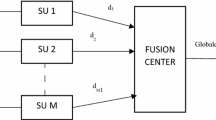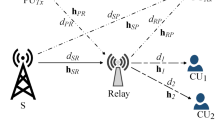Abstract
Cognitive Radio (CR) Network is a wireless communication technology, in which a detection device smartly detects occupied and unoccupied channels. During traffic, unused primary user spectrum space is allotted to a secondary user, without causing any intervention with the primary user. Though this has reduced network traffic to a great extent, many issues related to security has became an alarming problem, in which the primary user’s space is misused by some malicious secondary users without the knowledge of primary user. To address this issue, in this paper we have proposed a Boundary detection method that uses the estimated location of each SU, which is obtained using the Recurrent Neural Network algorithm, to determine the boundary of PU coverage. Then Malicious User Detection by Ordering (MUDO) methodology is proposed, in which all secondary users are weighed using Basic Probability Analysis (BPA), and based on the orders the SUs are paired with corresponding PUs. The SUs with the least orders are discarded as they might be malicious users. The proposed methodology possesses higher detection speed and precise detection thereby enhancing the performance of CR.






Similar content being viewed by others
References
Mourougayane, K., Amgothu, B., Bhagat, S., & Srikanth, S. (2019). A robust multistage spectrum sensing model for cognitive radio applications. AEU International Journal of Electronics and Communications, 110, 152876.
Mohammad Mehdi Hassani. (February 2018). Reza Berangi, “A new congestion control mechanism for transport protocol of cognitive radio sensor networks.” AEU - International Journal of Electronics and Communications, 85, 134–214.
Kumar, A., Thakur, P., Pandit, S., & Singh, G. (2020). Threshold selection and cooperation in a fading environment of cognitive radio network: Consequences on spectrum sensing and throughput. AEU - International Journal of Electronics and Communications, 117, 153101.
Mobini, Z. (2021). Secure cooperative spectrum sharing in full-duplex multi-antenna cognitive radio networks with jamming. AEU International Journal of Electronics and Communications., 128, 153495.
Hoque, S., & Arif, W. (2018). Impact of secondary user mobility on spectrum handoff under generalized residual time distributions in cognitive radio networks. AEU - International Journal of Electronics and Communications, 86, 185–194.
Alkady, M. S., Abd-Elnaby, M., El-Dolil, S. A., & Abd El-Samie, F. E. (2019). An Adaptive sensing time based on SNR for spectrum utilization enhancement in cognitive radio. Wireless Personal Communications, 106, 307–319.
Mahendru, G., Shukla, A., & Banerjee, P. (2020). A novel mathematical model for energy detection based spectrum sensing in cognitive radio networks. Wireless Personal Communications., 110, 1237–1249.
ElHassan, M. A., Abd-Elnaby, M., El-Dolil, S. A., & Abd El-Samie, F. E. (2019). Adaptively controlled cooperative spectrum sensing using or fusion rule for throughput maximization in cognitive radio. Wireless Personal Communications, 109, 2095–2105.
Yadav, K., Dhar Roy, S., & Kundu, S. (2020). Defense against spectrum sensing data falsification attacker in cognitive radio networks. Wireless Personal Communications., 112, 849–862.
Verma, G., & Sahu, O. P. (2018). A distance-based reliable cooperative spectrum sensing algorithm in cognitive radio. Wireless personal communications., 99, 203–212.
Alaa Rabie Mohamed, Ahmad A. Aziz El-Banna, Hala A. Mansour (2021) Multi-path hybrid spectrum sensing in cognitive radio arabian journal for science and engineering.
Alhamad, R., & Boujemaa, H. (2019). Multihop multibranch spectrum sensing for cognitive radio networks. Arabian Journal for Science and Engineering., 44, 6711–6726.
Avila Jayapalan, Prem Savarinathan, Jagathi Chenna Reddy, Janani Divyadharshini Baskar (2021) Detection and Defense of PUEA in Cognitive Radio Network. Arabian Journal for Science and Engineering.
Das, D., & Khadanga, R. K. (2021). Adaptive price estimation in cognitive radio enabled smart grid networks. Arabian Journal for Science and Engineering., 46, 1451–1463.
Salameh, H., Shraideh, S., & Alshamali, A. (2020). Joint channel assignment and adaptive mode selection in MIMO-based cognitive radio networks. Arabian Journal for Science and Engineering., 45, 10233–10244.
Kumar, A., Thakur, P., Shweta, P., & Singh, G. (2019). Analysis of optimal threshold selection for spectrum sensing in a cognitive radio network: an energy detection approach. Wireless Networks., 25, 3917–3931.
Kalpana Devi, M. & Umamaheswari, K. (2021). Optimization techniques for spectrum handoff in cognitive radio networks using cluster-based cooperative spectrum sensing. Wireless Networks
Alok Kumar, S., & Pandit, G. S. (2021). Threshold selection analysis of spectrum sensing for cognitive radio network with censoring based imperfect reporting channels. Wireless Networks., 27, 961–980.
Maji, P., Yadav, K., Roy, S., & Kundu, S. (2020). Secrecy and throughput performance of an energy harvesting hybrid cognitive radio network with spectrum sensing”. Wireless Networks., 26, 1301–1314.
Patel, D. K., López-Benítez, M., Soni, B., & García-Fernández, Á. F. (2020). Artificial neural network design for improved spectrum sensing in cognitive radio. Wireless Networks., 26, 6155–6174.
Salam, F. M., & Oh, H. J. (1999). Design of a temporal learning chip for signal generation and classification. Analog Integrated Circuits and Signal Processing, 18, 229–242. https://doi.org/10.1023/A:1008315507084
Maundy, B. J., & El-Masry, E. I. (1991). Feedforward associative memory switched-capacitor artificial neural networks. Analog Integrated Circuits and Signal Processing, 1, 321–338. https://doi.org/10.1007/BF00239679
Patil, AM., Patil, MD., Birajdar, GK (2020) White blood cells image classification using deep learning with canonical correlation analysis. IRBM.
Dudul, S. V. (2007). Identification of a liquid saturated steam heat exchanger using focused time lagged recurrent neural network model. IETE Journal of research, 53(1), 69–82.
Singh, A. K., Tyagi, B., & Kumar, V. (2013). Application of feed forward and recurrent neural network topologies for the modeling and identification of binary distillation column. IETE Journal of Research., 59(2), 167–175.
Kanungo, A., Mittal M., Dewan, L. (2020) Critical analysis of optimization techniques for a MRPID Thermal System Controller. IETE Journal of Research: 1–16.
Mahalakshmi, P., N. Sabiyath Fatima. (2021). Ensembling of text and images using deep convolutional neural networks for intelligent information retrieval. Wireless Personal Communications: 1–19.
Swain, R. R., & Khilar, P. M. (2017). Composite fault diagnosis in wireless sensor networks using neural networks. Wireless Personal Communications, 95(3), 2507–2548.
Author information
Authors and Affiliations
Corresponding author
Additional information
Publisher's Note
Springer Nature remains neutral with regard to jurisdictional claims in published maps and institutional affiliations.
Rights and permissions
About this article
Cite this article
Brinda , V., Bhuvaneshwari, M. Identifying Malicious Secondary User Presence Within Primary User Range in Cognitive Radio Networks. Wireless Pers Commun 122, 2687–2699 (2022). https://doi.org/10.1007/s11277-021-09025-7
Accepted:
Published:
Issue Date:
DOI: https://doi.org/10.1007/s11277-021-09025-7




